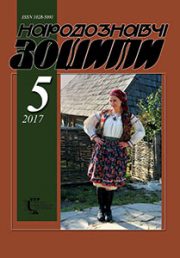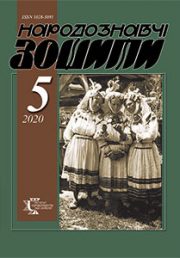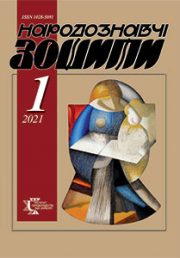The Ethnology Notebooks. 2019, 1 (145), 57—65
UDK 745.52(477):7.036.1 “1930/1960”
DOI https://doi.org/10.15407/nz2019.01.057
UKRAINIAN THEMATIC CARPET OF 1930 —1960s AS AN ART PRACTICE OF SOCIAL REALISM
YAMBORKO Olha
ORCID ID: https://orcid.org/0000-0003-0340-5436
Candidate of Art Studies, Associate Professor, Teacher
Institute of Arts of Vasyl Stefanyk
Precarpathian National University,
Department of Design and Theory of Art
34a, Sakharova str., 76000, Ivano-Frankivsk, Ukraine
Contacts: e-mail: kalyna015@gmail.com
Abstract. The article deals with the factors of the formation of the phenomena of thematic carpet weaving in the Ukrainian art of the 1930s—1960s. The specifics of the development of this artistic practice in the conditions of the Soviet totalitarian system were highlighted, and the decisive influence of socialist realism on the visual stylistics and the genre structure of the woven panel was determined. The main focus is on carpet themes, hierarchy of genres, and also shown as this kind of carpet weaved on the prospects of Ukrainian and other post-Soviet national textile art schools.
Keywords: thematic carpet, socialist realism, ideology.
Received 25.01.2019
REFERENCES
Golomshtok, I. (1994). Totalitarian art. Moscow: Galart [in Russian].
Golomshtok, I. (1976). The language of art under totalitarianism. Kontinent, 7, 331— 391 [in Russian].
Gundorova, T. (2008). Socialist realism: between modern and avant-garde. Slovo і Chas, 4, 4—21 [in Ukrainian].
Gjunter, H. (2000). The Life Stages of the Socialist Realism Canon. In H. Gjuntera, E. Dobrenko (Ed.), Socrealisticheskij kanon (pp. 281—288). St. Petersburg: Academic project [in Russian].
Gjunter, H. (2000). The totalitarian state as a synthesis of the arts. In H. Gjuntera, E. Dobrenko (Ed.), Socrealisticheskij kanon (pp. 7—15). St. Petersburg: Academic project [in Russian].
Dneprov, V. (1957). Ideal image and image typical. Novyj mir, 7, 218—236 [in Russian].
Dobrenko, E. (2004). Socialist Realism and Real Socialism. Colloquia, 18, 57—91 [in Russian].
Dobrjans’ka, І., & Zapasko, Ja. (1956). Carpet weaving artillery «“Victory» in the village of Glynyany, Lviv region. Materials on ethnography and artistic production (Vol. ІІ, pp. 21—23) [in Ukrainian].
Zhdanov, A. (1934). Soviet literature is the most ideological, most advanced literature in the world: speech at the first All-Union Congress of Soviet Writers. Moscow: Hud.lit. [in Russian].
Zhuk, A. (1973). Ukrainian Soviet carpets. Kyiv: Naukova dumka [in Ukrainian].
Zhuk, A. (1981). Ukrainian Leniniana in decorative art. Obrazotvorche mistectvo, 4, 9—11 [in Ukrainian].
Le, І. (1955). Zmichka. In I. Le (Ed.). Writings (pp. 64—75). Kyiv: Derzh. vid-vohud. lіt-ry [in Ukrainian].
Lejderman, N. (2002). Trajectories of the «experimental era». Questions of literature, 4 [in Russian].
Manucharova, N. (1952). Decorative and applied art of the Ukrainian SSR: (According to the exhibition materials 1949). Kyiv: Vid-vo AA URSR [in Ukrainian].
Mochalov, L. (1986). The problem of realism in Soviet art. Problemy sovremennogo iskusstva. In L. Mochalov (Ed.). Problems of Modern Art (pp. 15—22). Moscow: Sovetskij hudozhnik [in Russian].
Novytska, M. (1948). Thematic Carpets of Soviet Ukraine. Visnyk Akademiyi arkhitektury URSR, 4, 24—32 [in Ukrainian].
Petrovskaja, E. (2012). Socialist Realism: High Low Art. In E. Petrovskaja (Ed.). Unnamed: Community. Moscow: Falanster [in Russian].
Rohotchenko, O. (2016). Fine Arts of Ukraine 1940—1960s: ways of development and artistic and stylistic peculiarities. (Doctoral dissertation). Tchaikovsky National Music Academy of Ukraine [in Ukrainian].
Sverbilova, T. (2008). The project of national identification of national social realism and drama of the 30-th of the twentieth century. Slovo i Chas, 4, .21—29 [in Ukrainian].
Fedoriv, U.(2016). Socialist Realistic Canon in the Ukrainian Literature: Mechanisms of Formation and Transformation. (Ph.D. dissertation). Ivan Franko National University of Lviv [in Ukrainian].
Kharkhun, V. (2008). Leniniana as an aesthetic project. Slovo i Chas, 7, 33—43 [in Ukrainian].
Kharkhun, V. (2010). Socialist Realistic Canon in the Ukrainian Literature: Genesis, Development, Modifications (Dr. philos. sci. diss. abstr.). Kyiv [in Ukrainian].
Jankovskaja, G. (2002). Artists in the years of late Stalinism: Everyday life and (or) ideology. Slavica Lundencia, 22, 269—286 [in Russian].






